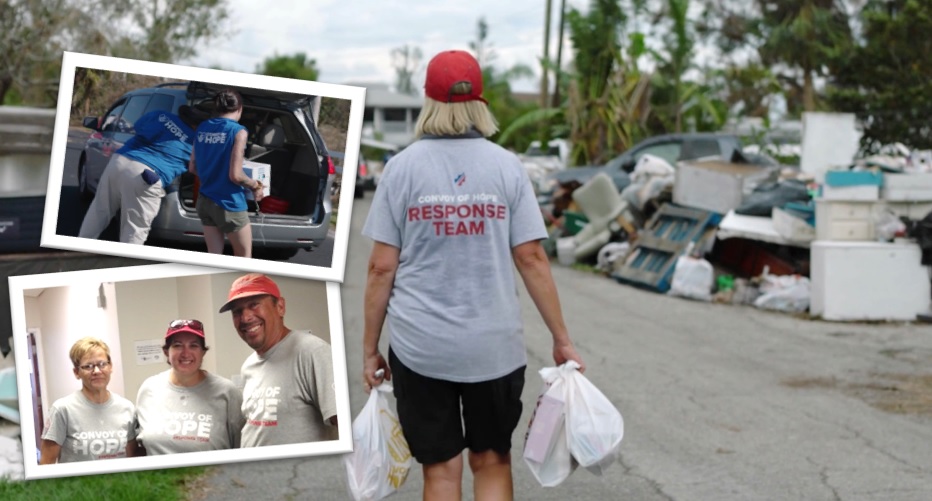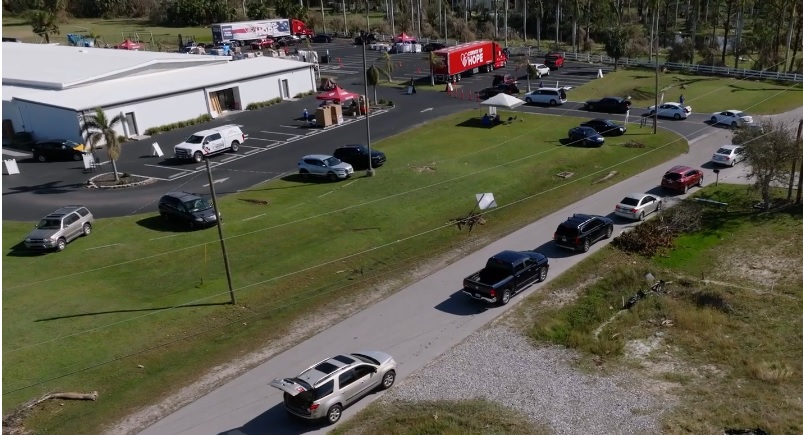There are a few reasons why the non-profit Convoy of Hope played an over-sized role in the disaster recovery during the category 4 hurricane Ian this year. Specifically, the organization helped more than 115,000 people recover from Hurricane Ian.
First, Convoy of Hope moves at incredible speed. The Convoy trucks drive to the hurricane zone just as the hurricane leaves so they can distribute aid the moment it is safe. One reason to provide relief assistance as quickly as possible is to help families salvage their homes from storm surge. Saltwater is devastating to land and structures, destroying vegetation and hastening corrosion of exposed metals and other building materials.
Secondly, Convoy of Hope uses high-tech trucks to bring an entire self-contained encampment of volunteers, supplies and equipment. As much as they are able, Convoy brings in their own food, fuel and water so they do not need to obtain them from the community they are helping at a time when those resources are strained. These high-tech trucks contain full shower, laundry, sleep quarters and kitchen facilities for the small army of volunteers to use so that there is no need to go outside the camp for help. Many of the more than 1,500 volunteers come to “pay it forward” after receiving help in the past from Convoy of Hope. They bring a spirit of eagerness to help their neighbors.
Convoy also comes with ready-made meals for quick distribution to meet the needs of first wave of people in need. Relief includes 1.5 million pounds of food, water, and other supplies. Early in the relief efforts, Convoy teams distributed bottled water, nonperishable food and roof repair kits at a distribution center in Fort Myers.
Finally, Convoy of Hope works in partnership with and in service to local community organizations. In Fort Myers, the hardest hit area, they helped a local church. Our observation from witnessing disaster relief around the world has shown us that those charities that work with local communities are the most effective, enduring and helpful. After working to distribute food, Convoy switched to providing debris removal help to impacted homes. Long term, they provided building materials and helped with home repairs.
Since Convoy distributes aid alongside local organizations, like a church, people see the church and get connected to its services, which can help them long after the disaster is gone. Any organization can arrive into a disaster zone and unload warehouses full of supplies, but quantity of help should never replace quality of help. Even small acts of kindness make a difference. One couple could each take only one backpack when the Coast Guard rescued them. After receiving another person’s shirt “literally… off their back,” along with other clothing and cleaning supplies, they expressed gratitude to Convoy of Hope.
The story gets even better when we encountered other, what we call super-charities, in the same disaster area working miracles in the same fashion. We were able to see how Billy Graham’s Samaritan’s Purse and a coalition of Baptist disaster relief organizations worked.
We learned that civic leaders and local governments really depend on the help of such private relief organizations. They have found that they are able to help in unique ways that municipal organizations are unable to. Because of this unique service, Florida’s Governor Office made sure to work with such groups and help promote their services in their public announcements.
These are just some ways that Convoy of Hope, Samaritan’s Purse and Baptists disaster relief coalition organizations have worked hard to maximize their effectiveness and help during a disaster. They are able to do more with less. This is a role model opportunity that other charities, ministries and civic institutions should learn from.
— By Taxpayers Foundation of Oregon
Disclaimer: Articles featured on Oregon Report are the creation, responsibility and opinion of the authoring individual or organization which is featured at the top of every article.




